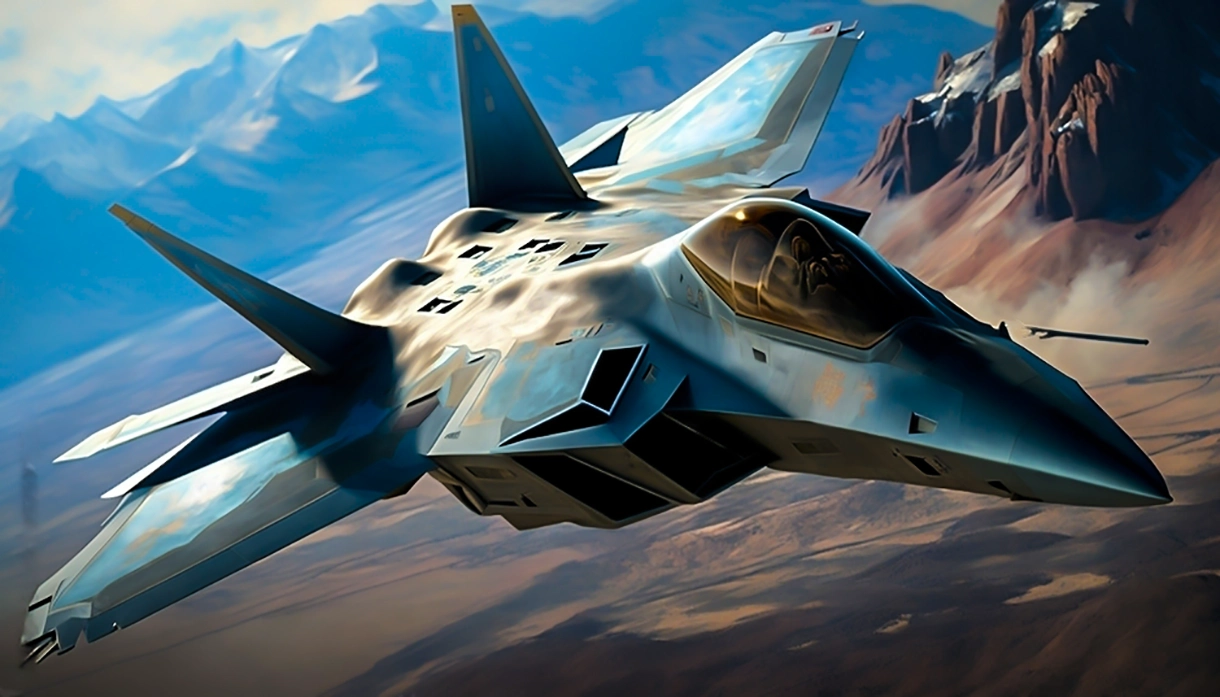Emerging from the depths of time, the mighty F-22 Raptor maintains its regency over the skies a quarter century after its first powered roar.
The Timeless Lord of the Skies: A Cry of Supremacy
Even at this age, the venerable F-22 Raptor, a fifth-generation Falcon, stealthy, and fast-paced fighter, holds the title of the undisputed ruler of air dominance. This incontrovertible consensus drives tireless efforts to revitalize and strengthen this predator of the skies, predicting its reign until the sixth decade of the century.
Sure, the Pentagon’s sixth-generation eagle is already flying, bold and invisible, destined to surpass its predecessor in almost every way. However, the retirement of the F-22 is not yet on the horizon for the Air Force. The reason is clear: in terms of speed, maneuverability, and air superiority, the Raptor remains an unrivaled adversary in the global theater.

In this theater, the Air Force and Lockheed Martin have been working hand-in-hand on a series of high-end technological upgrades for the Raptor, improving its weaponry, speed, aiming, range, radar, and stealth capabilities.
Tuning the Celestial Harpoon: Weapons and Software Upgrades
For the past five years, Lockheed Martin has been on a joint mission with the Air Force to update software for the entire Raptor fleet. This project, dubbed 3.2b, has supercharged the bird of prey’s computing, detection, and targeting capabilities.
The integrated upgrade has catapulted the effectiveness of the Raptor’s AIM-9X and AIM-120D air-to-air weapons, providing substantial improvements in range, accuracy, and guidance technology.

The Lockheed-Air Force partnership has modified the Raptor’s arsenal, integrating a variant of the AIM-9X Block II with a renewed fuze and a digitized ignition safety system.
Transforming the Vulture into a Phoenix: improvement in Abilities
These mods optimize maneuverability on the ground and add “post-launch lock” capability via a new data link, ensuring unsurpassed amiability beyond the line of sight, according to Raytheon data.
The AIM-9X employs an infrared plane focal array for “beyond the line of sight” targeting. With the aid of a helmet-mounted targeting system or state-of-the-art sight, a pilot can guide the AIM-9X missile simply by looking at the target.

Thus, the F-22 Raptor, the condor of the cosmos, continues to reign supreme, proving that time has not eroded its majesty or its dominance in the skies.
The reinforced condor: AIM-120D and the art of “fire and forget”
The 3.2b metamorphosis also adds an edge to the AIM-120D, an Advanced Medium-Range Air-to-Air Missile (AMRAAM) that transcends visibility, engineered for twilight-of-night or dawn-of-day strikes, unfazed by inclement weather. This “fire-and-forget” war device carries an active-transmitting radar as its guiding beacon, according to Raytheon data.
The AIM-120D is born with substantial improvements over its AMRAAM predecessors, increasing the attack range, GPS navigation, inertial measurement units and a bidirectional data link, according to Raytheon sources.
Interestingly, despite being conceived as a high-speed air supremacy platform, the F-22 has expanded its theater of operations in recent years to perform roles such as “close air support,” forward detection and airfield liaison, sharing target details and real-time data with other players on the war board, be they 4th generation aircraft, command centers or drones.
The interconnection of aerial leviathans: F-22 and F-35
As part of this effort, the Air Force has been designing a “two-way” data link between the F-22 and F-35 so that crucial battle details can be exchanged “both ways” between these two. 5th generation eagles.
This is vitally important, as previous LINK 16 applications only allowed one-way data transmission. In addition, industrialists of the stature of Northrop Grumman have designed the 550 Freedom radio, which, thanks to its advanced frequency technology, establishes the connection between the F-22 and F-35 without compromising their stealth.
The F-22 made its baptism of fire in Iraq against ISIS in 2014, demonstrating its close air support (CAS) capability. Given its speed and maneuverability, the F-22 can be ideally positioned to track and engage ground targets with advanced air-to-ground and precision-guided weapons.
The F-22 on the war chessboard: strategy and Perspectives

Although it is not known for certain how much small-arms fire an F-22 could withstand, it is likely that this celestial vulture used its speed, precision and maneuverability to be lethal in a high-threat scenario.
The F-22 could deploy its “supercruise” technology, achieving Mach speeds without the need for afterburners. This capability extends high-speed operations and improves vectoring in both air-to-ground and air-to-air engagements.
A few years ago, the strategic success of the F-22, bolstered by years of technological improvements, sparked a debate in the Pentagon and in Congress about “reviving” the production line. The original plan for the fleet was drastically reduced after the end of the Cold War.
The future of the F-22 fleet: an endangered species?
Currently, approximately 169 F-22s exist, a number well below the original plan for the fleet. After a long debate several years ago, the heads of the Department of Defense and Congress decided to postpone the restart of production of the F-22.
This could largely be due to a lack of political will but also to the fact that early conceptual work on the 6th generation stealth fighter, known as Next Generation Air Dominance (NGAD) had already started.
Therefore, the history of the F-22 is not yet written in its entirety, its next chapters being a mystery that awaits to be revealed in the offices of the Pentagon and the skies of the future.



